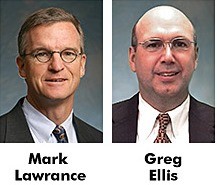The recent news that parts of five Indiana counties have been pushed out of attainment for ambient air quality and exceed a new U.S. Environmental Protection Agency (EPA) standard for sulfur dioxide comes as no shock.
Indeed, the U.S. EPA continues to lower the standards, making it increasingly difficult for communities to meet the new requirements.
U.S. EPA officials point to coal-fired power plants as the main contributors to the release of more sulfur dioxide than is permitted in the new standards. Sulfur dioxide is a colorless gas that contributes to acid rain that damages the environment and can worsen breathing problems.
Parts of Marion, Morgan, Daviess, Pike and Vigo counties are the ones that have now been pushed out of attainment. For a number of years, all 92 counties have met the necessary levels for ambient air quality standards. But the U.S. EPA has continued to tighten the belt on standards that measure carbon monoxide, lead, nitrogen dioxide, ozone, particulate matter and sulfur dioxide.
Hoosier regulators now have 18 months to draft a plan telling how the counties will come back into compliance within five years.
So it sounds like Indiana’s air is just dirtier than ever, right?
Nope. In fact – it’s much cleaner than it’s ever been in our lifetimes. This 2011 BizVoice® story on the state of Indiana’s environment points to significant improvement in Hoosier air, water and land quality. But that’s hardly the story everyone hears.
For the story, I spoke with Dr. William Beranek Jr., president of the Indiana Environmental Institute, a third-party forum for analysis and understanding of Indiana’s environmental protection laws, rules and policies.
This is what he told me at the time: “We have been steadily and significantly improving across this timeframe (past 20 to 30 years), by sulfur dioxides, by nitrogen dioxide, by ozone, by lead and by particulates,” he explains.
“One of the challenges we’ve had across this time is that the technical community – for better or worse – has been steadily determining that some of those parameters are actually more harmful to human health than we had thought. Therefore, while we had been steadily improving the quality of the air, the indicator of whether we have good air has been steadily tightening. We’re at a point where we’re just as far from the finish line as we were when we started.”
Another expert on the matter: Bernie Paul, president of B Paul Consulting and former air quality expert for Eli Lilly & Company, also pointed to the federal process used for evaluating and changing air quality standards – starting with the Clean Air Act of 1970. That legislation was written so that all standards are re-evaluated every five years, and that cost implications cannot be taken into consideration when creating air quality standards.
“For a public agency to have to re-evaluate technical information every five years, when it takes 10 years to execute the plans to bring the air quality level down to where they set it, that’s a broken process,” he insists.
“A 10-year or even a 20-year review cycle would make more sense, because it takes so long for all of the implementation to be executed. We really can’t have a system where you’re constantly churning the standard.”
How does this relate to you? If coal-fired power plants are pointed to as the problem with these new regulations and the only way to match the requirements is to add more emission controls (or phase out coal altogether, as some would suggest), that means your electricity rates will go up.
Organizations including the U.S. Energy Information Association (EIA) and the Natural Resources Defense Council (NRDC) provide estimates between 83% and 95% of Indiana’s electricity coming from coal-fired power plants. It affects jobs here too: the EIA ranks Indiana as eighth in coal production in the country.
These are just some things to keep in mind the next time you read a story about Indiana’s “dirty” air.

 The many programs and benefits of Indiana Chamber membership include the state’s deepest and most effective group of issue experts. That team welcomes two talented additions.
The many programs and benefits of Indiana Chamber membership include the state’s deepest and most effective group of issue experts. That team welcomes two talented additions.
 The
The